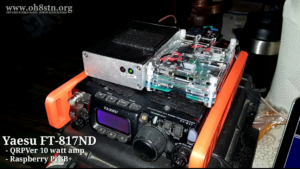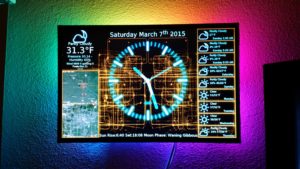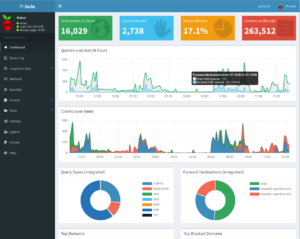One of the responsibilities of the Technical Coordinator in the Ohio Section is to submit something for the Section Journal. The Section Journal covers Amateur Radio related things happening in and around the ARRL Ohio Section. It is published by the Section Manager Scott – N8SY and articles are submitted by cabinet members.
Once my article is published in the Journal, I will also make it available on my site with a link to the published edition.
You can receive the Journal and other Ohio Section news by joining the mailing list Scott has setup. You do not need to be a member of the ARRL, Ohio Section, or even a ham to join the mailing list. Please sign up!
If you are an ARRL member and reside in the Ohio Section, update your mailing preferences to receive Ohio Section news in your inbox. Those residing outside the section will need to use the mailing list link above.
Updating your ARRL profile will deliver news from the section where you reside (if the leadership chooses to use this method).
Go to www.arrl.org and logon.
Click Edit your Profile.
You will be taken to the Edit Your Profile page. On the first tab Edit Info, verify your Email address is correct.
Click the Edit Email Subscriptions tab.
Check the News and information from your Division Director and Section Manager box.
Click Save.
Now without further ado…
Read the full edition at:
THE TECHNICAL COORDINATOR
Jeff Kopcak – TC
k8jtk@arrl.net
My article last month covered Raspberry Pi and problems users have experienced with the Pi 4 since its release last year. I gave some tips for keeping your Pi running like a top including choosing better power components, SD cards, and having the Pi run cooler despite higher idle temperatures. This month will cover recent projects you can make with the Raspberry Pi to learn about the device, computer programming, or Linux.
Ham Pi – formally the “W3DJS Raspberry Pi for Ham Radio image” is an operating system for the Raspberry Pi with over 80 ham radio applications pre-installed – which include digital modes, APRS clients, antenna programs, SDR, Morse Code, radio programming, and more. Dave wanted to have a Pi image loaded with any ham radio software application he might ever want to use. He initially shared it with a few club members and soon realized there was demand when his image had over 8,000 downloads. Since then, the build process is automated using an Ansible playbook. The playbook is also available on his github which is useful if you want to learn a provisioning technology or build your own customized version. A long time ago, I wrote instructions that just  compiled Fldigi and Flmsg on a Pi2 for a go-box. Ham Pi is a definite must for anyone that has a Pi already in their go-box or wants to add one to an existing box.
compiled Fldigi and Flmsg on a Pi2 for a go-box. Ham Pi is a definite must for anyone that has a Pi already in their go-box or wants to add one to an existing box.
Build a Pi – wanting a way to have ham radio applications installed on a Pi, Jason – KM4ACK wrote a script that does just that. Having many issues with the first couple implementations, which were mostly copy-and-paste installs, it was not flexible enough to update applications once installed. Version 3 includes an automated way of installing and configuring both ham radio applications and the operating system on a fresh Raspberry Pi OS installation. Differing from Ham Pi in that a stock Raspberry Pi OS download can be used, the user can also pick-and-choose which applications they want to install. A quick tutorial video is available.
Rig Pi Station Server – is a Raspberry Pi that controls your station and on-air activities. With a Station Server install and web browser or smartphone app, you can control a radio, rotor, use CW, operate digital modes, look for spots, and even upload your log. If you don’t want to spend much time learning about the Pi or Linux with the above projects, this is the way to get on the air remotely as quickly as possible. Hackaday did a review on the Rig Pi Remote Server.
“Rig Pi” may sound familiar because it was picked up and packaged by MFJ as the 1234 with a Pi and audio interface HAT. Before I receive complains (I’ve already seen them online), you can download the help and schematics as well as any of the software on the github repository absolutely free. Rig Pi is open-source. Not only that but no one needs to buy the commercial package. It can be installed yourself. People that complain about “selling” open-source projects really don’t understand how that typically works. It is common practice to release an enterprise grade software application as FOSS (free and open-source). A company/individual/whomever will make money on their application by selling licenses, services, or hardware. Same concept here. Assuming the license allows it, a vendor can package the program as part of a device. I’m going to assume the developer is getting a cut or donation as part of MFJ’s sales (but I don’t know this) as the product is promoted on the project page.
Pi-Star – create a digital hotspot or repeater with a Pi and transmitter. Providing complex services and easy configuration via a web interface, Pi-Star solved the problem of fragmentation when different hotspot boards all had their own Pi image. Most didn’t work well if at all. Pi-Star solved that problem by providing an easy to use interface for the beginner and allowing a tinkerer to dig deep into settings. Using the MMDVM suite from G4KLX, it can operate DMR, D-STAR, NXDN, P25, and System Fusion (depending on modem) and use many different protocols. This software is packaged and sold with different hotspot devices such as the ZUMSpot. Another example of software being packaged with hardware and sold commercially.

Ultimate Raspberry Pi Build – Julian – OH8STN from Finland covers topics related to off-the-grid and grid-down operating. He brings us an excellent instructional video on making a very portable QRP digital station using a Raspberry Pi. He set out to build a smaller and, in turn, much more portable setup than is available commercially with other devices. This video details hardware mods, HAT options, and software needed to operate digital, off-grid, from anywhere.

Pi Clocks – a couple of clock projects are available depending on your level of interest. The first one is created by Kevin – N0BEL. It’s not a project specifically for Hams rather for anyone interested in making a nice weather display. His PiClock is a clock (“duh” – as he says) with weather forecast and radar map display. Though it could be used in the shack, it is better suited for a common area in the house, such as the kitchen, with an HDMI monitor. Everyone likes weather information. Emile – KE5QKR from Amateur Logic did a PiClock tutorial.
HamClock project – from Elwood – WB0OEW is geared toward the ham shack. It has clock (again, duh), current temperature and weather conditions, solar conditions, VOCAP predictions, satellites, DX spots and daylight map. His project can be built on any UNIX-like operating system including the Raspberry Pi. It cannot run naively on Windows but can run on a Unix system and displayed on Windows using X server forwarding. This has the appearance of a regular Windows application. Tommy – N5ZNO of Amateur Logic did a segment on setting up the HamClock.
Open Repeater – I lost track of this project. I first heard about it back in 2014 when they didn’t yet have a domain name for the project. Goal is to create an open-source and simple to use repeater controller. Utilized for high-profile repeaters or basic simplex nodes, the software walks the user through setting up a repeater controller. Owners can have traditional Morse IDs or create longer messages at every hour via audio recordings. Having SVXLink at the core allows seamless integration with VoIP modes like Echolink. Additional modules can be added to the core package providing more functionality.
Pi-Hole – not specifically Ham Radio related but a fantastic network appliance. DL6ER, a ham radio operator in Germany, is a Developer and Administrator for the project. Pi-Hole acts as a Domain Name System (DNS) sinkhole (returning a fake value) which blocks devices on a home network from accessing ad sites, trackers, or other malicious websites. Though originally intended for Raspberry Pi devices, it has been expanded to include any Linux operating system or docker container. It doesn’t filter bandwidth or inspect network traffic. The Pi-Hole acts as the DNS server for a home network instead of your ISP. DNS is referred to as the “phone book” of the Internet by looking up names such as arrl-ohio.org and returning the IP address in order for a network device to access the server hosting the Ohio Section website. When a request for a blacklisted website (such as some-malicious-website[dot]com) is requested, Pi-Hole intercepts and returns a different IP address so the access request will never reach the Internet. This is better compared to a web browser plug-in because Pi-Hole is inspecting DNS requests for all network devices.

It’s great to block trackers and ad sites in theory, keeps digital footprints to a minimum and reduces the chance of fraud through scareware-type tactics. In practice, it often blocks couponing and deal websites as well as promotional email links from a favorite restaurant. Those emails are coded to tell the sender which links a recipient clicked and can be used to measure the effectiveness of an advertising campaign. Whitelist exceptions can be granted though the very nice web interface when legitimate sites are blocked. I have a similar application running on my network. After I received complaints about sites being blocked (but they wouldn’t tell me when there were problems to create exceptions), I disabled this blocking all together, effectively opening up the Internet. Within 10 minutes I was asked to turn it back on as pop-up ads immediately started to appear stating ‘your computer is INFECTED.’ Scared the, uh, stuff out of some. Other issues involve in-home advertising and monitoring devices, like Alexa, which freak out when the device can’t reach its severs. These devices flood the local network with hundreds of DNS requests per second. Smart TVs and Rokus often have similar problems when they can’t reach their servers to track what is being watched. Data feeds containing bad sites are aggregated for free, so you get what you pay for. Sites are frequently categorized as bad when they really aren’t. Some are legitimate services. Blocking these sites could cause undesired behavior, for example, using a favorite streaming TV service where you may receive errors.
Windows 10/desktop replacement – with the power and speed of the Raspberry Pi 4, many are finding ways to install traditional operating systems. Windows 10, in its many flavors, has an IoT stripped down version for devices like the Pi. The guide at Tom’s Hardware shows how to get the full desktop version of Windows 10 running on the Pi. It’s a little sluggish and not for the faint of heart but if you screw up, just start over.
There are plenty more ham radio and non-ham projects to do on a Raspberry Pi. Applications listed in the first couple projects can be installed standalone for single use setups such as a Slow Scan TV (SSTV) receiver when the International Space Station is sending images. A friend in Toledo recently used my instructions to setup an APRS RX Igate. DL1GKK’s site has instructions on installing ham radio applications as well. Raspberry Connect contains a list of ham radio applications that can be installed through the apt package manager which simplifies installation. There is no shortage of things to make on a Raspberry Pi.

News missed my article last month, but I wanted to mention the passing of Grant Imahara at 49 years old due to a brain aneurysm. Most probably never heard the name but have undoubtedly seen his work. Not a ham radio licensee that anyone can find, Grant was an electronics genius and maker in the truest sense of the word. Landing jobs at ILM (Industrial Light and Magic), the George Lucas special effects company, he modernized R2D2. He was one of three official domestic operators of the droid for the Star Wars movies. His special effects movie credits also include The Lost World: Jurassic Park, Terminator 3, and Matrix movies. Grant also competed on BattleBots where his robot was often highly ranked. The robotic sidekick on “The Late Late Show with Craig Ferguson” was also Grant’s creation. He was a designer for the animatronic Energizer Bunny seen in commercials. Joining MythBusters in 2005 is where I picked up his career in front of the camera during my college years. The program took on myths, legends, and Hollywood lure to see if they translated to real-life – oh, and they liked to blow stuff up. Grant not only provided technical expertise but participated in experiments and designed machines to take the place of a person for myths that were too dangerous. A tragic loss and he will be missed.
Thanks for reading and 73… de Jeff – K8JTK
